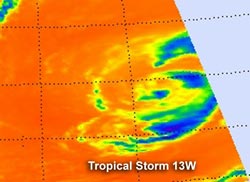Infrared NASA Imagery Shows a Weaker Tropical Storm 13W

NASA's Aqua satellite passed over Tropical Storm 13W on August 7 at 0253 UTC. The AIRS instrument captured an infrared image of the cloud temperatures that showed very limited strong storms (purple) and most of the precipitation was to the east of the center of circulation.<br>Credit: NASA JPL, Ed Olsen <br>
Infrared satellite imagery from shows how cold cloud top temperatures are in a tropical cyclone, and recent imagery from NASA's Aqua satellite shows the cloud-top temperatures have been warming in Tropical Storm 13W. Warming cloud top temperatures indicate less strength, and Tropical Storm 13W is weakening.
NASA's Aqua satellite passed over Tropical Storm 13W on August 7 at 0253 UTC. The Atmospheric Infrared Sounder (AIRS) instrument that flies onboard Aqua captured an infrared image of the storm's cloud temperatures that showed very limited strong thunderstorms make up the tropical cyclone and most of the precipitation was to the east of the center of circulation. The AIRS imagery also shows that the bands of thunderstorms around the center are fragmented.
On August 7 at 1500 UTC (11 a.m. EDT), Tropical Storm 13W's (TS13W) maximum sustained winds were near 35 knots (40.2 mph/64.8 kmh). TS13W was located 745 nautical miles (857 miles/1,380 km) north-northwest of Wake Island, near 30.2 North and 160.5 East. It was moving to the northwest near 9 knots (10.3 mph/16.6 kmh).
The Joint Typhoon Warning Center forecasters noted that Tropical Storm 13W “Continues to maintain a warm core and will likely dissipate before transitioning to a subtropical or extra-tropical system.”
Text Credit: Rob Gutro
NASA Goddard Space Flight Center, Greenbelt, Md.
Media Contact
All latest news from the category: Earth Sciences
Earth Sciences (also referred to as Geosciences), which deals with basic issues surrounding our planet, plays a vital role in the area of energy and raw materials supply.
Earth Sciences comprises subjects such as geology, geography, geological informatics, paleontology, mineralogy, petrography, crystallography, geophysics, geodesy, glaciology, cartography, photogrammetry, meteorology and seismology, early-warning systems, earthquake research and polar research.
Newest articles

A universal framework for spatial biology
SpatialData is a freely accessible tool to unify and integrate data from different omics technologies accounting for spatial information, which can provide holistic insights into health and disease. Biological processes…

How complex biological processes arise
A $20 million grant from the U.S. National Science Foundation (NSF) will support the establishment and operation of the National Synthesis Center for Emergence in the Molecular and Cellular Sciences (NCEMS) at…

Airborne single-photon lidar system achieves high-resolution 3D imaging
Compact, low-power system opens doors for photon-efficient drone and satellite-based environmental monitoring and mapping. Researchers have developed a compact and lightweight single-photon airborne lidar system that can acquire high-resolution 3D…





















